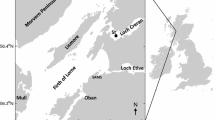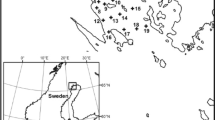Abstract
A study of the isotopic composition of organic matter was conducted in a freshwater marsh over seasonal and diel time scales to determine the sources of dissolved organic matter (DOM) and the processes leading to its formation. Bulk C and N isotopic compositions of the bacterial fraction (0.2–0.7 μm) and particulate organic matter (POM; 0.7–10 μm) were compared on a seasonal basis with the change in δ13C of DOM. The bulk isotopic data support the idea that DOM was, in part, derived from the breakdown of larger organic matter fractions. The bacterial fraction and POM were compositionally similar throughout the year, based on a comparison of the δ13C of individual amino acids in each fraction. Annual variation in the δ13C of amino acids in DOM was greater relative to the variation in larger fractions indicating that microbial reworking was an important factor determining the proteinaceous component of DOM. The 13C enrichment of serine and leucine in each organic matter fraction suggested microbial reworking was an important factor determining organic matter composition during the most productive times of year. Changes in the bulk δ13C of DOM were more significant over daily, relative to seasonal, time scales where values ranged by 6‰ and followed changes in chlorophyll a concentrations. Although bulk δ13C values for POM ranged only from −29 to −28‰ during the same diel period, the δ13C of alanine in POM ranged from −30 to −22‰. Alanine is directly synthesized from pyruvate and is therefore a good metabolic indicator. The δ13C of individual amino acids in DOM revealed the diel change in the importance of autotrophic versus heterotrophic activity in influencing DOM composition. Diel changes in the δ13C of phenylalanine, synthesized by common pathways in phytoplankton and bacteria, were similar in both DOM and POM. The diel change in δ13C of isoleucine and valine, synthesized through different pathways in phytoplankton and bacteria, were distinctly different in DOM versus POM. This disparity indicated a decoupling of the POM and DOM pools, which suggests a greater source of bacterial-derived organic matter at night. The results of this study demonstrate the use of the isotopic composition of individual amino acids in determining the importance of microbial reworking and autotrophic versus heterotrophic contributions to DOM over both diel and seasonal time scales.
Similar content being viewed by others
References
Abelson P.H. and Hoering T.C. 1961. Carbon isotope fractionation in formation of amino acids by photosynthetic organisms. Proceedings of the National Academy of Science USA 47: 623–632.
Amon R.M.W. and Benner R. 1996. Bacterial utilization of different size classes of dissolved organic matter. Limnology and Oceanography 41: 41–51.
Azam F., Fenchel T., Field J.G., Gray J.S., Meyey-Reil and Thingstad F. 1983. The ecological role of water-column microbes in the sea. Marine Ecology – Progress Series 10: 257–263.
Bano N., Moran M.A. and Hodson R.E. 1997. Bacterial utilization of dissolved humic substances from a freshwater swamp. Aquatic Microbial Ecology 12: 233–238.
Benner R., Pakulski J.D., McCarthy M., Hedges J.I. and Hatcher P.G. 1992. Bulk chemical characteristics of dissolved organic matter in the ocean. Science 255: 1561–1564.
Benner R., Biddanda B., Black B. and McCarthy M. 1997. Abundance, size distribution, and stable carbon and nitrogen isotopic compositions of marine organic matter isolated by tangential-flow ultra-filtration. Marine Chemistry 57: 236–243.
Boschker H.T.S., de Brouwer J.F.C. and Cappenberg T.E. 1999. The contribution of macrophyte-derived organic matter to microbial biomass in salt-marsh sediments: Stable carbon isotope analysis of microbial biomarkers. Limnology and Oceanography 44: 309–319.
Briggs S.V., Maher M.T. and Tongway D.J. 1993. Dissolved and particulate organic carbon in two wetlands in southwestern New South Wales, Australia. Hydrobiologia 264: 13–19.
Cabana G. and Rasmussen J.B. 1996. Comparison of aquatic food chains using nitrogen isotopes. Proceedings of the National Academy of Sciences (USA) 93: 10844–10847.
Cowie G.L. and Hedges J.I. 1994. Biochemical indicators of diagenetic alteration in natural organic matter mixtures. Nature 369: 304–307.
Dalva M. and Moore T.R. 1991. Sources and sinks of dissolved organic carbon in a forested swamp catchment. Biogeochemistry 15: 1–19.
Engel M.H. and Hare P.E. 1985. Gas-liquid chromatographic separation of amino acids and their derivatives. In: Garrett G.C. (ed.), Chemistry and Biochemistry of Amino Acids. Chapman and Hall, London, pp. 462–479.
Fogel M.L. and Cifuentes L.A. 1993. Isotope fractionation during primary production. In: Engel M.G. and Macko S.A. (eds), Organic Geochemistry. Plenum, New York, NY, USA, pp. 73–98.
Fogel M.L. and Tuross N. 1999. Transformation of plant biochemicals to geological macromolecules during early diagenesis. Oecologia 120: 336–346.
Goni M.A. and Thomas K.A. 2000. Sources and transformations of organic matter in surface soils and sediments from a tidal estuary (North Inlet, South Carolina, USA). Estuaries 23: 548–564.
Gottschalk G. 1988. Bacterial Metabolism. Springer-Verlag, New York, pp. 359.
Hassan A.A. 1982. Methodologies for extraction of dissolved inorganic carbon for stable carbon isotope studies: evaluation and alternatives. Report No. 82–6. Water-Resources Investigations, U.S. Geological Survey.
Hayes J.M. 1993. Factors controlling 13C contents of sedimentary organic compounds: Principles and evidence. Marine Geology 113: 111–125.
Hedges J.I. 1992. Global biogeochemical cycles: progress and problems. Marine Chemistry 39: 67–93.
Hemond H.F. 1990. Wetlands as the source of dissolved organic carbon to surface waters. In: Perdue E.M. and Gjessing E.T. (eds), Organic Acids in Aquatic Ecosystems. Wiley, New York, NY, USA, pp. 310–314.
Hobbie J.E. and Wetzel R.G. 1992. Microbial control of dissolved organic carbon in lakes – Research for the future. Hydrobiologia 229: 169–180.
Hoch M.P., Fogel M.L. and Kirchman D.L. 1992. Isotope fractionation associated with ammonium uptake by a marine bacterium. Limnology and Oceanography 37: 1447–1459.
Hoch M.P., Fogel M.L. and Kirchman D.L. 1994. Isotope fractionation associated with ammonium uptake by marine microbial assemblages. Geomicrobiology Journal 12: 113–127.
Jeffrey S.W. and Humphrey G.F. 1975. New spectrophotometric equations for determining chlorophylls a, b, c and c2 in higher plants, algae, and natural phytoplankton. Biochemistry and Physiology of Plants 167: 191–194.
Kaplan L.A. and Bott T.L. 1982. Diel fluctuations of DOC generated by algae in a piedmont stream. Limnology and Oceanography 27: 1091–1100.
Kaplan L.A. and Bott T.L. 1983. Microbial heterotropic utilization of dissolved organic matter in a piedmont stream. Freshwater Biology 13: 363–377.
Keil R.G. and Fogel M.L. 2001. Reworking of amino acid in marine sediments: Stable carbon isotopic composition of amino acids in sediments along theWashington Coast. Limnology and Oceanography 46: 14–23.
Kortelainen P. 1993. Contribution of organic acids to the acidity of Finnish Lakes. Publications of the Water and Environment Research Institute 13: 1–48.
Kracht O. and Gleixner G. 2000. Isotope analysis of pyrolysis products from Sphagnum peat and dissolved organic matter from bog water. Organic Geochemistry 31: 645–654.
Lee S.H. 1993. Measurement of carbon and nitrogen biomass and biovolume from naturally derived marine bacterioplankton. In: Kemp P.F., Sherr B.F., Sherr E.B. and Cole J.J. (eds), Aquatic Microbial Ecology. Lewis Publishers, NY, USA, pp. 319–325.
Lorenzen C.J. 1967. Determinations of chlorophyll and phaeo-pigments: Spectrophotometric equations. Limnology and Oceanography 12: 343–346.
Lytle C.R. and Perdue E.M. 1981. Free, proteinaceous, and humic-bound amino acids in river water containing high concentrations of aquatic humus. Environmental Science and Technology 15: 224–228.
Macko S.A., Engel M.H., Hartley G., Hatcher P.G., Helleur R., Jackman P. et al. 1991. Isotopic compositions of individual carbohydrates as indicators of early diagenesis of organic matter in peats. Chemical Geology 93: 147–161.
Macko S.A., Fogel M.L., Hare P.E. and Hoering T.C. 1987. Isotopic fractionation of nitrogen and carbon in the synthesis of amino acids by microorganisms. Chemical Geology 65: 79–92.
Mann C.J. and Wetzel R.G. 1995. Dissolved organic carbon and its utilization in a riverine wetland ecosystem. Biogeochemistry 31: 99–120.
Mann C.J. and Wetzel R.G. 2000. Effects of the emergent macrophyte Juncus effusus L. on the chemical composition of interstitial water and bacterial productivity. Biogeochemistry 48: 307–322.
McCarthy M., Pratum T. and Hedges J. 1997. Chemical composition of dissolved organic nitrogen in the ocean. Nature 390: 150–154.
McCarthy M.D., Hedges J.I. and Benner R. 1998. Major bacterial contribution to marine dissolved organic nitrogen. Science 281: 231–234.
McDowell W.H. and Likens G.E. 1988. Origin, composition, and flux of dissolved organic carbon in the Hubbard Brook Valley. Ecological Monographs 58: 177–195.
McLaughlin J.W., Lewin J.C., Reed D.D., Trettin C.C., Jurgensen M.F. and Gale M.R. 1994. Soil factors related to dissolved organic carbon concentrations in a black spruce swamp, Michigan. Soil Science 158: 454–464.
Meyer J.L., McDowell W.H., Bott T.L., Elwood J.W., Ishizake C., Melack J.M. et al. 1988. Elemental dynamics in streams. Journal of the North American Benthological Society 7: 410–432.
Mulholland P.J. and Kuenzler E.J. 1979. Organic carbon export from upland and forested wetland watersheds. Limnology and Oceanography 24: 960–966.
Peterson B.J. 1999. Stable isotopes as tracers of organic matter input and transfer in benthic food webs: A review. Acta Oecologia 20: 479–487.
Porter K.G. and Feig Y.S. 1980. The use of DAPI for identifying and counting aquatic microflora. Limnology and Oceanography 25: 943–948.
Prahl F.G., Hayes J.M. and Xie T.M. 1992. Diploptene: An indicator of terrigenous organic carbon in Washington coastal sediments. Limnology and Oceanography 37: 1290–1300.
Quay P.D., Wilbur D.O., Richey J.E., Hedges J.I., Devol A.H. and Victoria R. 1992. Carbon cycling in the Amazon River: Implications from the 13C compositions of particles and solutes. Limnology and Oceanography 37: 857–871.
Scott J.H., Fogel M.L. and Emerson D. 2001. Use of the d13C associated with amino acid biosynthesis as a proxy for examining the flow of carbon through biological systems. Astrobiology 1: 340–341.
Silfer J.A., Engel M.H., Macko S.A. and Jumeau E.J. 1991. Stable carbon isotope analysis of amino acid enantiomers by conventional isotope ratio mass spectrometry and combined gas chromatography-isotope ratio mass spectrometry. Analytical Chemistry 63: 370–374.
Skoog A. and Benner R. 1997. Aldoses in various size fractions of marine organic matter: Implications for carbon cycling. Limnology and Oceanography 42: 1803–1813.
Solorzano L. 1969. The determination of ammonium in natural waters by phenolhypochlorite method. Limnology and Oceanography 14: 799–801.
Teece M.A., Fogel M.L. and Benner R. 1999. Stable carbon isotopic composition of individual carbohydrates in oceanic DOM: Elucidation of potential sources. Presented at the Aquatic Sciences Meeting of the American Society of Limnology and Oceanography, Santa Fe, NM, February 2, 1999.
Thurman E.M. 1985. Organic Geochemistry of Natural Waters. Martinus Nijhoff/Dr W. Junk, Norwell, MA, USA, pp. 497.
Tranvik L.J. 1993. Microbial transformation of labile dissolved organic matter into humic-like matter in seawater. FEMS Microbiology Ecology 12: 177–183.
Voet D. and Voet J.G. 1990. Biochemistry. John Wiley and Sons, New York, pp. 1223.
Volk C.J., Volk C.B. and Kaplan L.A. 1997. Chemical composition of biodegradable dissolved organic matter in streamwater. Limnology and Oceanography 42: 39–44.
Zieman J.C., Macko S.A. and Mills A.L. 1984. Role of seagrasses and mangroves in estuarine food webs: temporal and spatial changes in stable isotopic composition and amino acid content during decomposition. Bulletin of Mar. Sci. 35: 380–392.
Rights and permissions
About this article
Cite this article
Ziegler, S.E., Fogel, M.L. Seasonal and diel relationships between the isotopic compositions of dissolved and particulate organic matter in freshwater ecosystems. Biogeochemistry 64, 25–52 (2003). https://doi.org/10.1023/A:1024989915550
Issue Date:
DOI: https://doi.org/10.1023/A:1024989915550




